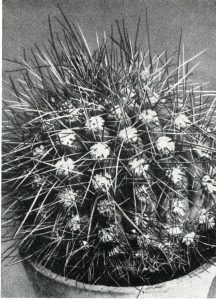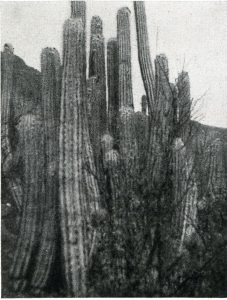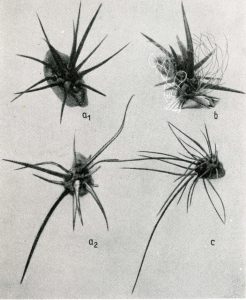Trichocereus taquimbalensis / Echinopsis tacaq. subsp. taquimbalensis
Current name: Echinopsis tacaquirensis ssp. taquimbalensis
Synonyms: Trichocereus tacaquirensis, Trichocereus werdermannianus, Helianthocereus werdermannianus, Echinopsis taquimbalensis, Echinopsis tacaquirensis, Echinopsis tacaquirensis ssp. taquimbalensis, Echinopsis tacaquirensis ssp. tacaquirensis, Trichocereus taquimbalensis var. wilkae
Trichocereus taquimbalensis is a pretty common cactus from Bolivia and can be found in collections throughout the world. There is large confusion around this plant because many of them come mislabeled as Trichocereus Werdermannianus. I have no idea if this confusion is caused by seed collectors or maybe because Backeberg´s Trichocereus Werdermannianus but the fact that Backeberg actually knew Taquimbalensis indicates that his Werdermannianus is rather some kind of Intermediate between Trichocereus Terscheckii and Trichocereus Taquimbalensis and the root of the error lies in seed collectors not being able to tell the both apart. Please note that Trichocereus Werdermannianus has definitely similarity to Trichocereus Taquimbalensis so it´s very likely it is related to that species.
Authentic Trichocereus Taquimbalensis has a bright green waxy epidermis and a number of rounded spines with a swollen base. They grow up to 2,50 meters tall and reach a diameter of 15 centimeters. Mature specimens have 8-9 Ribs with Areoles that are 1,5 centimeters apart. Areoles are Round to elliptic in shape and stand out up to 1 centimeter. Areoles are also white felted with 8-13 radial spines and up to 2 centimeters tall. One downward pointing middle spine that is up to 7 centimeters long and with thickening knobs at the base. Spines at first bright brown and later gray.
Flower: The flower is up to 23 centimeters long, ovaries 2,2 centimeters in diameter, with white and brown hairs and brown sepals that are up to 10 centimeters long. The Flowers are white. Trichocereus taquimbalensis is a day-flowering species.
Origin: Bolivia, provence Tarata, Department Cochabamba near Taquimbala, 2800 meters.
There is a variety var. WILKAE which was found by some women named Wilkae and it has more rounded spines and have four middle spines. This variety grows around Tupiza, which is a good distance away from the location of the type.
The modern taxonomy combines Trichocereus taquimbalensis and tacaquirensis and calls it Trichocereus tacaquirensis, with which I do not agree. Trichocereus tacaquirensis has a lot more spines, which are needlelike and the plant looks more like a tarijensis than a taquimbalensis. Basically 99% of all the plants labeled as Trichocereus tacaquirensis turned out to be some kind of Trichocereus taquimbalensis. While Trichocereus tacaquirensis is an extremely rare local variety of Tr. taquimbalensisis, the latter is extremely common and if any one of them should be a subspecies, it should definitely be Tr. tacaquirensis.
On google, there is a huge number of plants with the wrong label to be found as well, so every plant labeled tacaquirensis should be regarded with skepticism. So far, I cannot remember coming across Trichocereus tacaquirensis on the open market as a plant. Trichocereus taquimbalensis, on the other hand is very common.
I will now add some pics from backeberg in which he showed the differences between Trichocereus taquimbalensis and tacaquirensis. I agree that they are definitely related but since they are so easy to differentiate, I feel like it´s not legitimate to lump them both together.
Seed & Live Cutting Sources: I currently have a very limited amount of seeds available, but I do not have them in my shop yet. I also have some fresh seeds of Trichocereus tacaquirensis, and I am really happy I got some. If you are interested in some of my seeds, feel free to join my rare Seeds and Plants Newsletter.
Propagation: By seed or cuttings. But I actually had problems rooting this species and most cuttings I took did not survive. But that may only be true for the clone that I had and I heard about other growers having no problems rooting it.
Frost and Winter protection: Trichocereus taquimbalensis is a typical, cold hardy Trichocereus and can tolerate temperatures down to -5° celsius for very short periods of time. But I would absolutely not recommend keeping it at such low temperatures and it always depends on the general constitution of the plant. Besides, it has to be completely dry and I would recommend to keep it at temps of approximately 10° celius of you overwinter them inside. Wet soil is a killer and should be absolutely avoided.
Cultivation: Trichocereus taquimbalensis does not like full sun and I usually grow them in partial shade. It likes a little bit sun over the course of the day, but it tends to get sunburns pretty easily. If it get´s a severe sunburn, it can die pretty quickly. I only water them when it´s hot and only as much as it can take up within one day. They don’t like wet feet, but that´s something that is valid for most Trichocereus species. I stop watering them around the end of the summer and keep it dry over the winter.
This first Pic shows Trichocereus Tacaquirensis
Tr. tacaquirensis has many needlelike spines and a much higher spine count than Trichocereus taquimbalensis. Besides, it´s hardly possible to differentiate between middle and radial spines, which is something that is very easy with Tr. taquimbalensis. The whole plant looks more like some kind of a Tr. tarijensis and has a very different appearance than Tr. taquimbalensis. That said, they definitely are related.
Pic 2 shows the complete plant:
And last but not least, pic 3 shows a detailed comparison between the two varieties of taquimbalensis, oreocereus maximus and tacaquirensis.
a1. trichocereus taquimbalensis typus (top left)
a2. bottom left trichocereus taquimbalensis v. wilkae
b. oreocereus maxiumus
c. tacaquirensis
Note how many spines tacaquirensis has? You hardly come across them on the open market though i have seed. If anyone has the option to grow this one with free root run, I am happy to send some seed. It´s a huge spiny monster and moving it is not an option. It makes absolutely no sense to grow this one and move it and out in summer.
The difference between Trichocereus taquimalensis and Trichocereus tacaquirensis
And this plant is actually a very typical Trichocereus taquimbalensis! I will also add new Pictures to this Gallery too because it is actually a small specimen.
Trichocereus taquimbalensis / Echinopsis tacaq. subsp. taquimbalensis





Keine Kommentare:
Kommentar veröffentlichen